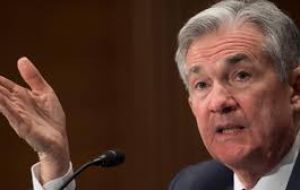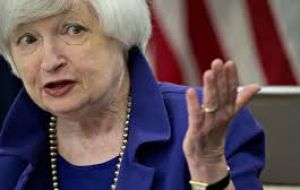MercoPress. South Atlantic News Agency
Powell's Fed confirms gradualism: anticipates 5 more modest rate increases in next 21 months
 Jerome Powell said the Fed expects to increase rates twice more this year, and in 2019 from two to three, reflecting on faster growth and lower unemployment.
Jerome Powell said the Fed expects to increase rates twice more this year, and in 2019 from two to three, reflecting on faster growth and lower unemployment.  The central bank boosted its key short-term rate by a modest quarter-point to a still-low range of 1.5% to 1.75% and said it will keep shrinking its bond portfolio
The central bank boosted its key short-term rate by a modest quarter-point to a still-low range of 1.5% to 1.75% and said it will keep shrinking its bond portfolio  The action was approved 8-0, avoiding any dissents at the first meeting that Powell has presided over as chairman since succeeding Janet Yellen last month.
The action was approved 8-0, avoiding any dissents at the first meeting that Powell has presided over as chairman since succeeding Janet Yellen last month.  A further acceleration of the economy is predicted driven in part by the sweeping tax cuts President Trump pushed through Congress in December
A further acceleration of the economy is predicted driven in part by the sweeping tax cuts President Trump pushed through Congress in December The Federal Reserve is raising its benchmark interest rate to reflect a solid U.S. economy and signaling that it's sticking with a gradual approach to rate hikes for 2018 under its new chairman, Jerome Powell. The Fed said it expects to increase rates twice more this year. At the same time, it increased its estimate for rate hikes in 2019 from two to three, reflecting an expectation of faster growth and lower unemployment.
The central bank boosted its key short-term rate Wednesday by a modest quarter-point to a still-low range of 1.5% to 1.75% and said it will keep shrinking its bond portfolio. Both steps show confidence that the economy remains sturdy nearly nine years after the Great Recession ended. The actions mean consumers and businesses will face higher loan rates over time.
The Fed's rate hike marks its sixth since it began tightening credit in December 2015. The action was approved 8-0, avoiding any dissents at the first meeting that Powell has presided over as chairman since succeeding Janet Yellen last month.
Some investors had speculated that Powell might move to impose his mark on the central bank by indicating a faster pace of rate hikes for 2018. But the new economic forecast, which includes a median projection for the path of future rate hikes, made no change to the December projection for three hikes this year.
If the Fed does stick with its new forecast for three rate increases this year and three in 2019, its key policy rate would stand at 3.4% after five years of credit tightening. Wednesday's forecast put the Fed long-term rate — the point at which its policies are neither boosting the economy nor holding it back — at 2.9%.
Speaking to Congress last month, Powell said his “personal outlook” on the economy had strengthened since December, when the Fed's policymakers collectively forecast three rate hikes for 2018, the same as in 2017. That comment helped send stocks tumbling because it suggested that the Fed might be about to accelerate the gradual pace it had pursued under his predecessor, Janet Yellen. More aggressive rate increases would likely slow the economy and make stocks less appealing.
Yet when he testified to Congress again two days later, Powell tempered his view: He stressed that the Fed still thinks it has room to maintain a moderate pace of rate hikes, in part to allow Americans' average wages, which have stagnated for years, to pick up. The impression was that he might not favor raising rates faster than Yellen did after all — at least not yet.
A healthy job market and a steady if unspectacular economy have given the Fed the confidence to think the economy can withstand further increases within a still historically low range of borrowing rates.
The financial markets have been edgy for weeks, and Powell's back-and-forth comments have been only one factor. A sharp rise in wage growth reported in the government's January jobs report triggered fears that higher labor costs would lead to higher inflation and, ultimately, to higher interest rates. Stocks sank on the news. But subsequent reports on wages and inflation have been milder, and the markets appear to have stabilized.
The February jobs report pointed to an unusually robust labor market: Employers added 313,000 jobs, the largest monthly gain in 12 years. The unemployment rate remained at a 17-year low of 4.1%.
Other measures of the economy, though, have been more sluggish. Consumer spending, the economy's primary fuel, has slowed this year and has led many economists to downgrade their forecasts for growth in the January-March quarter. Some now envision an annual growth rate of just 1.7% for the quarter.
Forecasts for all of 2018, though, still predict an acceleration later this year, driven in part by the stimulation effect of the sweeping tax cuts President Donald Trump pushed through Congress in December and a budget agreement last month to raise government spending by US$300 billion over two years.
If economic growth does pick up and the job market remains healthy, the Powell Fed is viewed as likely to accelerate its rate hikes, from the three it projected in December to four this year. Even after six rate increases over the past 27 months, the Fed's benchmark rate remains in a still-low range of 1.5% to 1.75%, up from a record low near zero as recently as December 2015.
FOMC note issued 21 March 2018:
Information received since the Federal Open Market Committee met in January indicates that the labor market has continued to strengthen and that economic activity has been rising at a moderate rate. Job gains have been strong in recent months, and the unemployment rate has stayed low. Recent data suggest that growth rates of household spending and business fixed investment have moderated from their strong fourth-quarter readings. On a 12-month basis, both overall inflation and inflation for items other than food and energy have continued to run below 2 percent. Market-based measures of inflation compensation have increased in recent months but remain low; survey-based measures of longer-term inflation expectations are little changed, on balance.
Consistent with its statutory mandate, the Committee seeks to foster maximum employment and price stability. The economic outlook has strengthened in recent months. The Committee expects that, with further gradual adjustments in the stance of monetary policy, economic activity will expand at a moderate pace in the medium term and labor market conditions will remain strong. Inflation on a 12-month basis is expected to move up in coming months and to stabilize around the Committee's 2 percent objective over the medium term. Near-term risks to the economic outlook appear roughly balanced, but the Committee is monitoring inflation developments closely.
In view of realized and expected labor market conditions and inflation, the Committee decided to raise the target range for the federal funds rate to 1-1/2 to 1-3/4 percent. The stance of monetary policy remains accommodative, thereby supporting strong labor market conditions and a sustained return to 2 percent inflation.
In determining the timing and size of future adjustments to the target range for the federal funds rate, the Committee will assess realized and expected economic conditions relative to its objectives of maximum employment and 2 percent inflation. This assessment will take into account a wide range of information, including measures of labor market conditions, indicators of inflation pressures and inflation expectations, and readings on financial and international developments. The Committee will carefully monitor actual and expected inflation developments relative to its symmetric inflation goal. The Committee expects that economic conditions will evolve in a manner that will warrant further gradual increases in the federal funds rate; the federal funds rate is likely to remain, for some time, below levels that are expected to prevail in the longer run. However, the actual path of the federal funds rate will depend on the economic outlook as informed by incoming data.
Voting for the FOMC monetary policy action were Jerome H. Powell, Chairman; William C. Dudley, Vice Chairman; Thomas I. Barkin; Raphael W. Bostic; Lael Brainard; Loretta J. Mester; Randal K. Quarles; and John C. Williams.




Top Comments
Disclaimer & comment rulesCommenting for this story is now closed.
If you have a Facebook account, become a fan and comment on our Facebook Page!